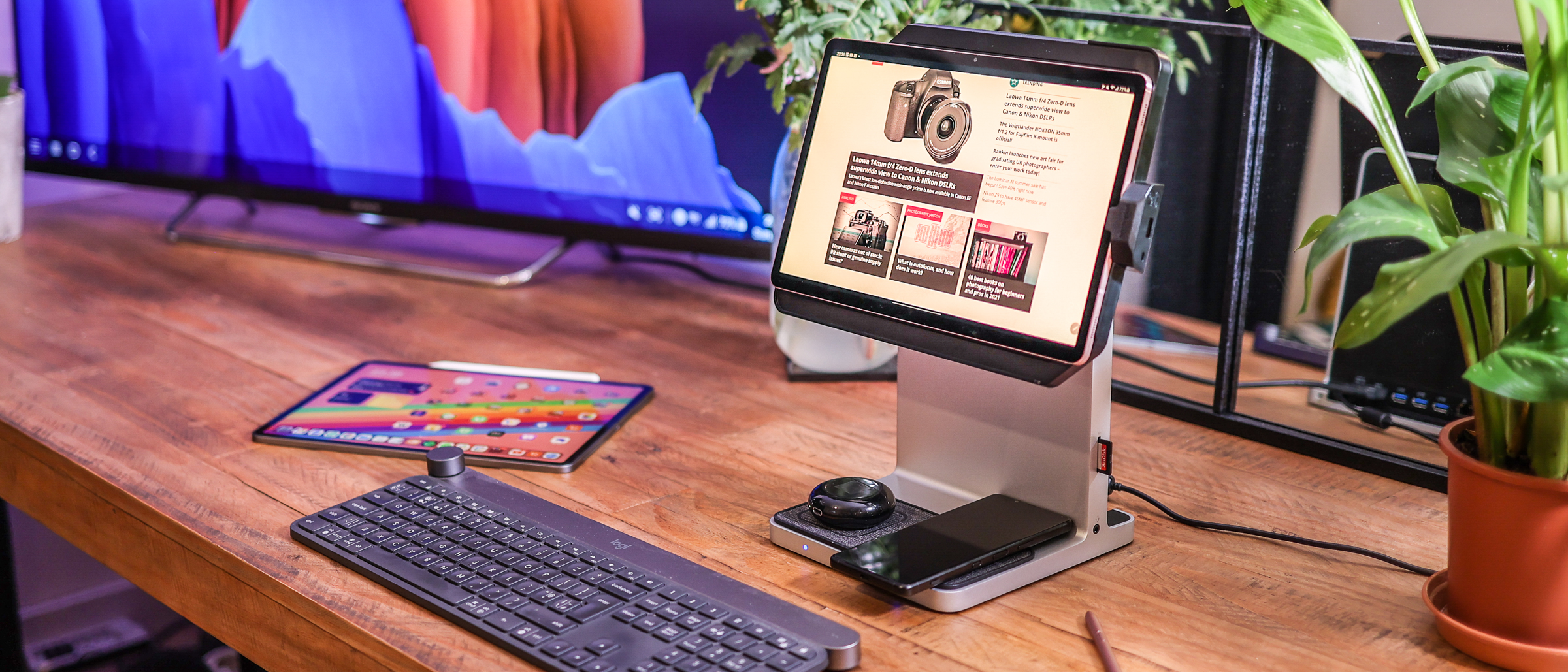Digital Camera World Verdict
If you’ve got an iPad Pro 11” (2018/2020/2021), an iPad Air (2020) or an iPad Pro 12.9" (2018/2020/2021), and want the fanciest dock on the block, the Kensington StudioDock is it. While its HDMI connectivity isn’t too useful, given the fact iPad OS doesn’t support extended screens and you can pick up an inexpensive dongle for a lot less, the dock’s ports, docking mechanism, wireless charging points and finish all make it stand out. For anyone who uses their iPad as a second monitor with an app like Sidecar or Duet, it’s also a dream. Can you get all the StudioDock’s features for less? Yes. But no rival solution is quite as polished and all-in-one as Kensington’s.
Pros
- +
Excellent build quality
- +
Plenty of ports and power options
- +
Two handy wireless chargers
- +
Easy to angle
Cons
- -
Expensive
- -
No height adjustment
- -
Sticky SD card reader
- -
HDMI port limited by iPad OS
Why you can trust Digital Camera World
The Kensington StudioDock is a beautiful bit of design, and elevates what is essentially a glorified USB-C hub to the upper echelons of the accessory world with blasted metal and Apple-esque styling. It’s designed for new models of the iPad Pro and iPad Air, adding a host of ports to the tablets, an SD card reader, and two wireless charging pads.
While it doesn’t add any revolutionary function to your tablet or workspace, and it does cost a lot, the longer we’ve been using it, the more we’ve relied on it as part of our iPad workflow, both as a versatile stand that holds your tablet in either portrait or landscape orientation, and as a dock that ekes out extra functionality out of Apple’s finest tablet.
Kensington StudioDock: pricing and availability
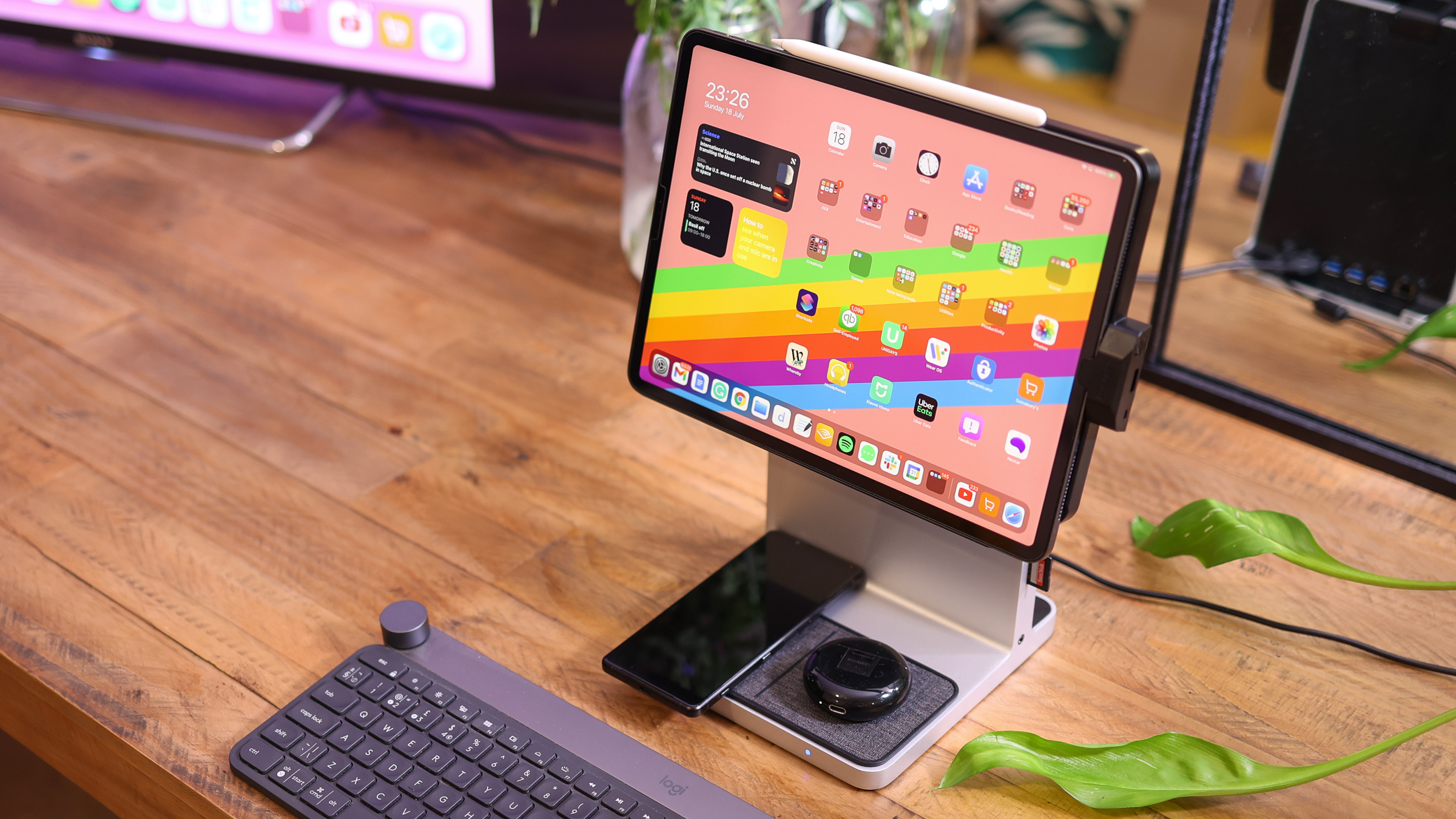
The Kensington StudioDock was announced in early 2021, but has taken a bit of time to launch around the world. It’s currently available in the US from roughly $379, and in the UK at around £350. Available in two versions, one with support for the 11-inch iPad Pro and Air and another supporting the 12.9-inch iPad Pro, we reviewed the larger of the two with our 12.9-inch 2018 iPad Pro. Compatible models include the iPad Pro 11” (2018/2020/2021), iPad Air (2020), and iPad Pro 12.9" (2018/2020/2021).
• Best iPads for photo editing
Kensington StudioDock: Design
The Kensington StudioDock is a solid thing. At 5.58kg, it sits firmly on a surface, weighing not much less than some small monitors. This is handy when poking cables into its ports – it won’t be sliding all over the place – and when docking your iPad, which magnetically secures onto the tablet, everything feels very solid.
Comprised of metal, plastic, and some fabric and rubber over the wireless charging pads – the dock’s curves and industrial shape match the design language of Apple’s iPads well.
With a swivel hinge that both tilts and turns, you can easily angle your iPad to face you both in portrait and landscape orientation, though the dock doesn’t rise and fall, so vertically, the tablet is relatively fixed. All in all, until you start tapping the plastic back panel, which is a touch hollow, everything about the StudioDock feels premium. Our one bugbear was that on our unit, the SD card reader’s spring mechanism is a little sticky.
• iPad generations - which Apple tablet is best for me?
Kensington StudioDock: connectivity
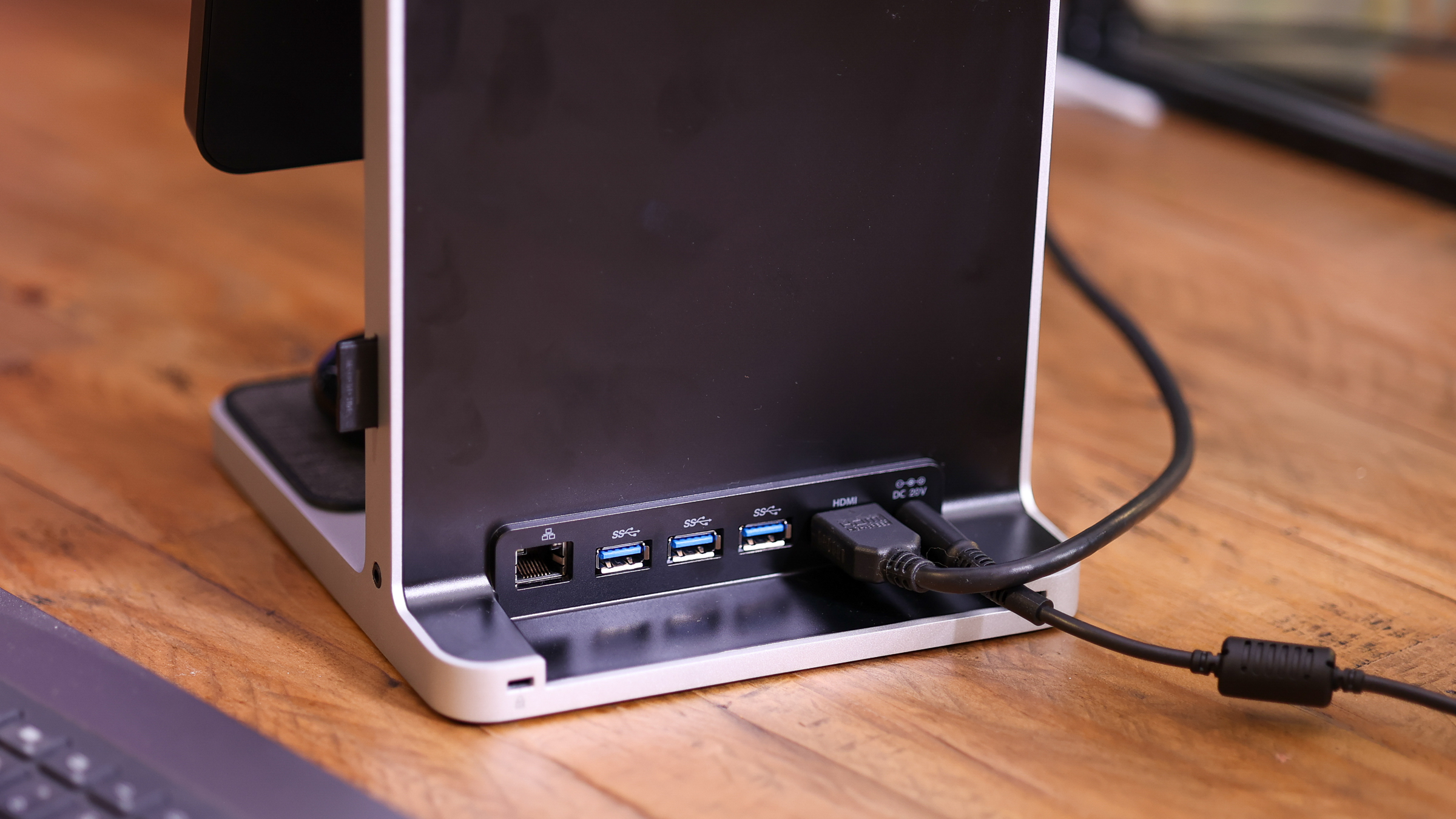
There are two aspects to the Kensington StudioDock: charging and docking. Starting with charging, the dock powers up your iPad at 37.5W, which is over double the speed of the charger that ships with the iPad. The dock also sports USB-A and USB-C ports that can power up gadgets by plugging them in directly. Finally, there are two wireless charging pads, one for a phone that charges at up to 7.5W, and the other for earbuds, which charge at up to 5W – though it can be used for a phone too, turning the dock into a multi-device charging hub.
As for the StudioDock’s connectivity, it features a single 4K HDMI 2.0 port, an SD card slot, which works well with apps like Lightroom for iPad, a Gigabit Ethernet jack, two USB-C ports and three USB-A ports, and finally, a headphone jack. There’s also a power button on the left side of the port.
As for the iPad docking process, the back panel of the iPad is magnetically guided as it nears the StudioDock, it slides over a USB-C connector which charges it, and powers up. On the subject of power, the StudioDock itself charges by plugging directly into the mains by way of a power brick with an IEC C5 connection.
Kensington StudioDock for photography
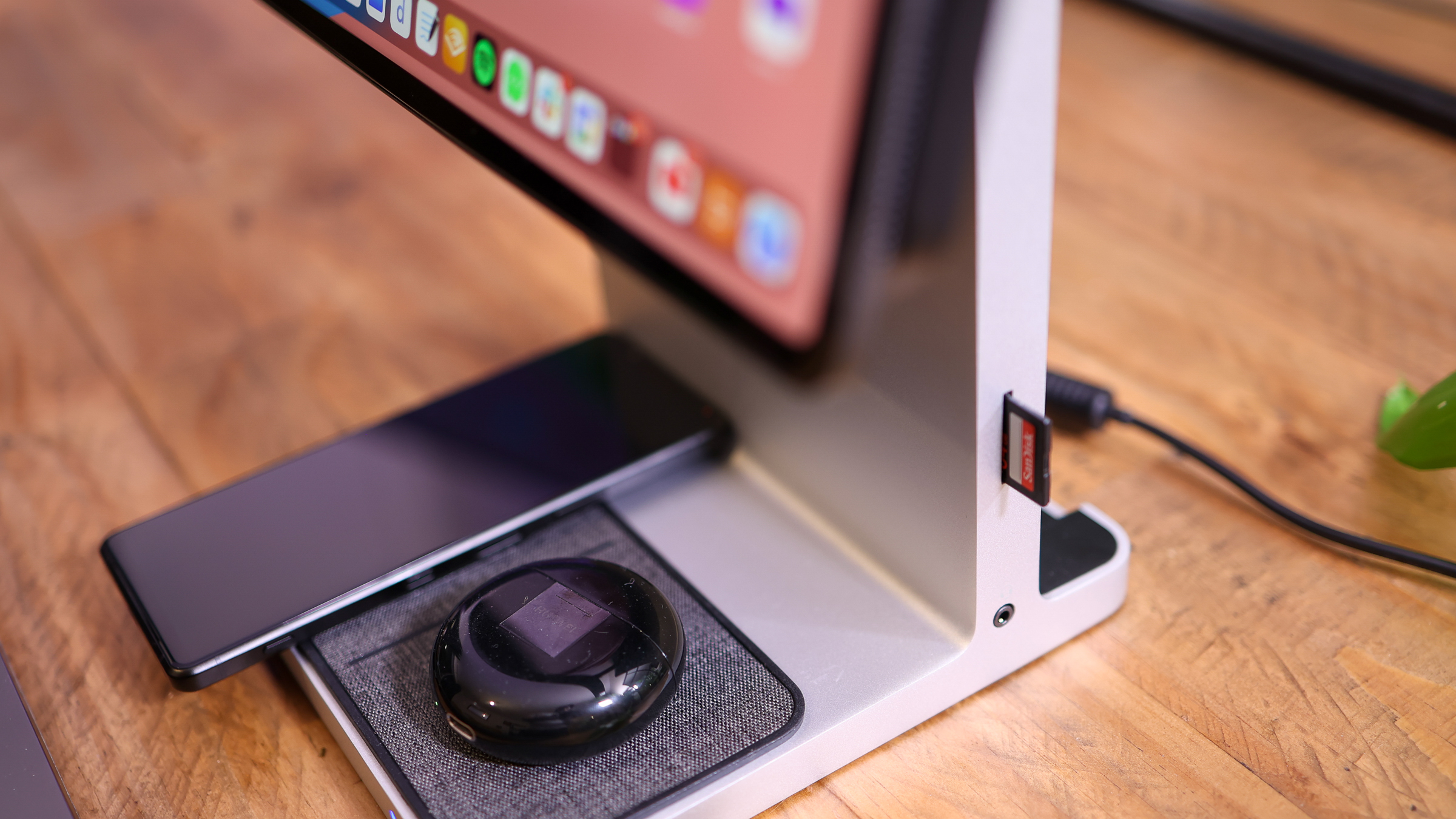
Thanks to the SD Card Slot matched with features available in the last few iterations of iOS, the StudioDock is primed to be a fantastic photography tool. The tablet has one of the best colour-calibrated screens around, so when matched with Lightroom and RAW files from your digital camera, you can edit extensively on it, and it’s especially ergonomic when paired with an Apple Pencil.
Additionally, with its HDMI output, the dock can project to any of the best monitors for photo editing around. Connect a Bluetooth mouse and keyboard, and the experience closely matches a laptop. For the most part, while the dock is incredibly pricey and you can get an SD card reader for a lot less, the all-in-one nature of the dock, and iPad OS’s rich photography app library come together well to make the dock a compelling option.
Kensington StudioDock Verdict
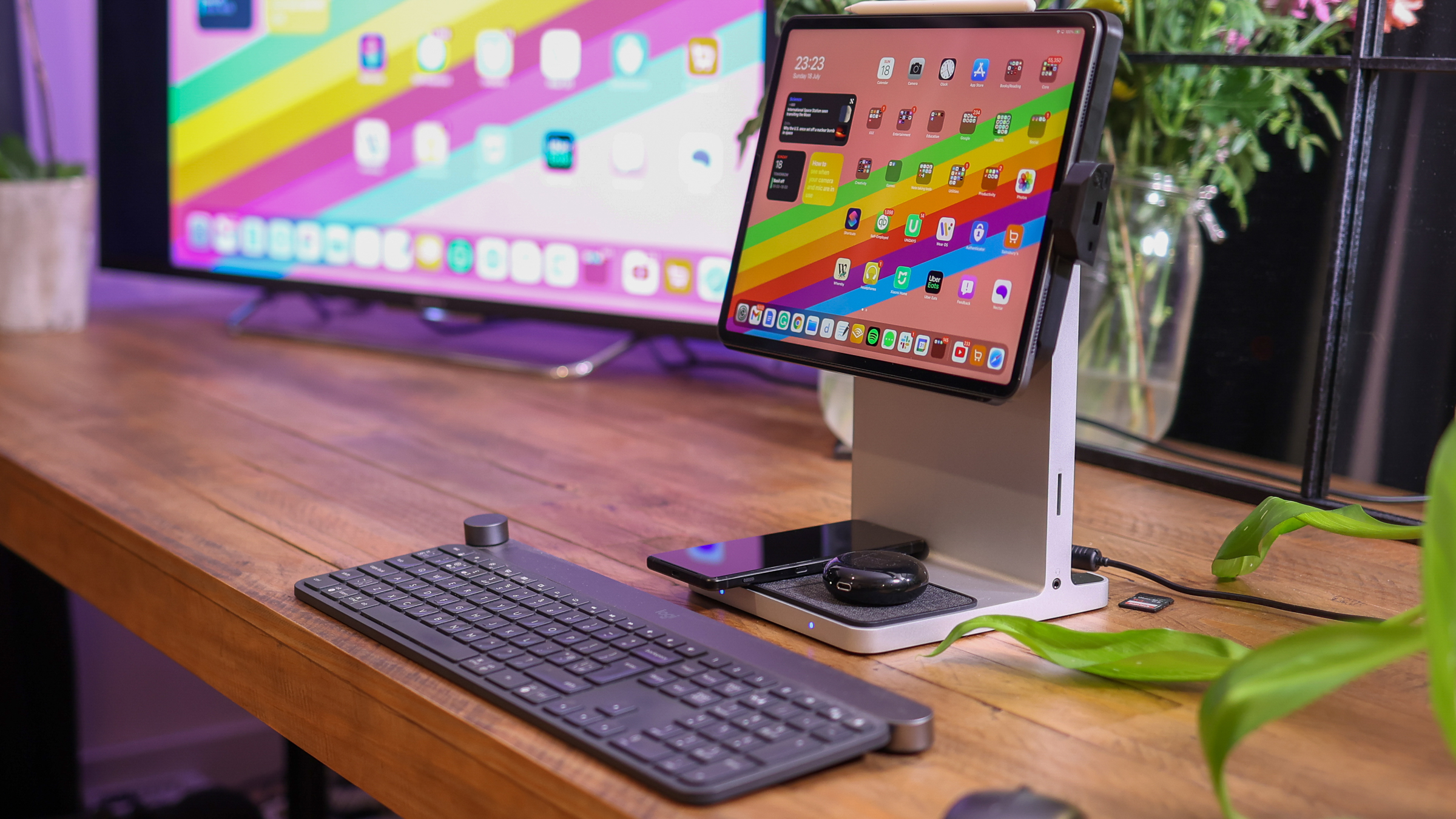
We didn’t find the Kensington StudioDock’s HDMI connectivity to be too useful, given the fact iPad OS doesn’t support extended screens and you can pick up an inexpensive dongle for a lot less. That said, Kensington has still made a very powerful accessory that could elevate your iPad Air or Pro workflow significantly.
The dock’s ports, docking mechanism, wireless charging points and finish all make it stand out, and anyone who uses their iPad as a second screen with an app like Sidecar or Duet, the StudioDock’s a great option, making your iPad a real alternative to a monitor. Given the hefty price tag of over $350 or £350 though, it’s anything but cheap.
You can get all the StudioDock’s features for less – two wireless charging points, a USB-C hub or dongle, SD card reader, headphone jack dongle etc; that will set you back a couple of hundred dollars or pounds – less if you’re thrifty. But what you can’t get elsewhere is all these elements in such a fine looking, all-in-one package, and that makes the StudioDock a unique, elegant, handy option that could be worth the cash for a specific type of iPad user.
Read more
Best iPad keyboard
Best iPad Pro cases
Best iPad Air cases
Best iPad Mini cases
Best iPad screen protectors
Basil Kronfli is a freelance technology journalist, consultant, and content creator. He trained in graphic design and started his career at Canon Europe before moving into journalism. Basil is also experienced in video production, independently running the YouTube channel TechEdit, and during his time at Future, he worked alongside the Digital Camera World team as a senior video producer.
